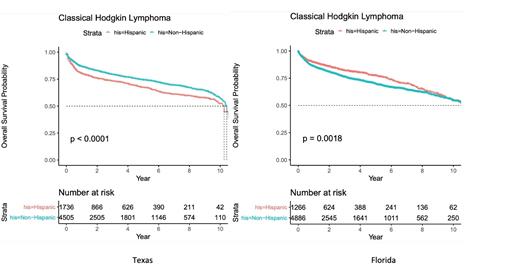Abstract
Introduction:
Classical Hodgkin lymphoma (cHL) accounts for about 90% of cases of HL. (Medicine PMID 26107683) Within cHL, there are 4 main histologic subtypes; the incidence of cHL varies based on age, race/ethnicity, geography, socioeconomic factors, Epstein Barr virus status, and the prevalence of HIV/AIDS. (Adv HematologyPMID 21197477) Considerable disparities exist in the incidence and survival rates between Hispanic (H) and non-Hispanic (NH) populations with cHL. (Ann Oncol PMID 22241896) Between 2013-2017, the incidence rate of cHL in Florida (FL) was 457 per 100,00, and in Texas (TX), it was 408 per 100,000. (North American Association of Central Cancer Registries, 2020) Our study aims to determine demographics, treatment outcomes, and survival outcomes of H and NH patients diagnosed with cHL in TX and FL.
Methods:
This is a retrospective study of a cohort of patients diagnosed with lymphoma (Hodgkin and Non-Hodgkin) from the Texas Cancer Registry (TCR) and the Florida Cancer Data System (FCDS) between 2006-2017. The third edition of the International Classification of Diseases for Oncology (ICD-O-3) was used to identify patient with cHL. Variables include gender, race, ethnicity, birthplace, occupation, dates at diagnosis and death, primary payer at diagnosis, subtype of lymphoma, stage, type of treatment, poverty index, and vitality status. The significance of variation in the distribution of categorical outcomes with ethnicity (H, NH) was assessed with Fisher's Exact tests or Pearson's Chi-square tests as appropriate; age was assessed with T-tests or Wilcoxon tests as appropriate. Survival time was measured in years from date of primary diagnosis to the date of death. Survival distributions were described with Kaplan-Meier curves and significance of variation in median survival with ethnicity was assessed with log rank testing. At risk tables were computed based on the Kaplan-Meier estimate of the survival curve. All statistical testing was two-sided with a significance level of 5%. Corrections for multiple testing were not applied.
Results:
There were 6152 (1266 H, 4886 NH) patients in FL and 6241(1736 H, 4505 NH) patients in TX identified with cHL. In FL, the median age at diagnosis was 44.8 years (y) for H vs 48.3y for NH (p < 0.001) while in TX, there was no statistically significant difference (45.8y H, 44.9y NH, p = 0.102). In FL, there was no statistically significant difference among females (44% H, 46% NH, p = 0.136) and males (56% H, 53% NH, p = 0.136) while there was one in TX among females (43% H, 45% NH, p = 0.048) and males (58% H, 55% NH, p = 0.048). In FL, the majority of H (40.5%) and NH (36.6%) were in the 10-19.9% poverty index (p<0.001). In TX, the majority of H (51.2%) were in the 20-100% poverty index while the majority of NH (32.2%) were in the 10-19.9% index (p<0.001). In FL, 10.7% H and 6.4% NH were without insurance at time of diagnosis (p<0.001) while in TX, 23.8% H and 11.7% NH were in that position (p<0.001). The most common stage of diagnosis was stage III/IV with 37.8% H vs 34.2% NH in FL (p<0.001) and 44.1% H vs 34.6% NH in TX (p<0001). In FL, median survival time was 10.6y H vs 11.4y NH, while in TX, it was 10.3y H vs 10.4y NH. In FL, the survival probabilities at years 2, 5, and 10 were 0.858, 0.774, and 0.550 for H vs 0.808, 0.696, and 0.545 for NH, respectively. In TX, the survival probabilities at years 2, 5, and 10 were 0.758, 0.674, and 0.522 for H vs 0.828, 0.743, and 0.579 for NH, respectively. The survival probability at years 2, 5, and 10 were higher for H compared to NH in FL (p = 0.0018), however the survival probability at years 2, 5, and 10 were lower for H compared to NH in TX (p < 0.0001).
Conclusion:
Our study of patients diagnosed with cHL demonstrated several statistically significant differences among H and NH patients in both states. Importantly, H patients in TX had a statistically significant lower survival probability at 2, 5, and 10y compared to NH patients. A reason for this could be the more significant number of uninsured H as compared to NH patients. Conversely, H patients in FL had a statistically significant higher survival probability at 2 and 5y compared to NH patients, partly explained by the lower median age of diagnosis of H patients compared to NH patients. There is a need for further analysis that could help explain the disparities among the different ethnicities.
Diaz Duque: Astra Zeneca: Research Funding; Epizyme: Consultancy; Morphosys: Speakers Bureau; Incyte: Consultancy; ADCT: Consultancy; Hutchinson Pharmaceuticals: Research Funding.


This feature is available to Subscribers Only
Sign In or Create an Account Close Modal